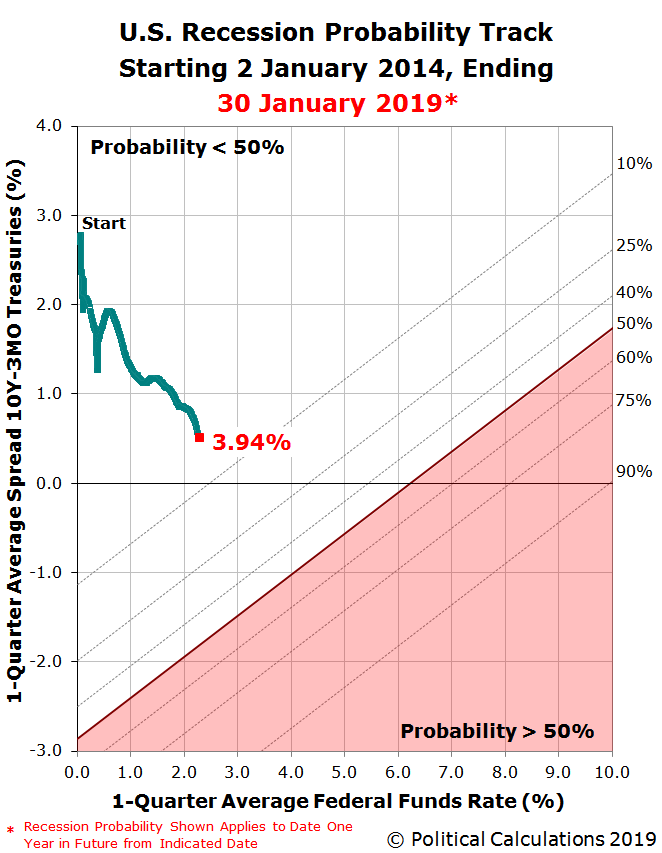The U.S. Federal Reserve finally backed off from hiking short term interest rates in the U.S., choosing to keep the target range of 2.25%-2.50% for the Federal Funds Rate.
The risk that the U.S. economy will enter into a national recession at some time in the next twelve months now stands at 3.9%, which is up by roughly one-and-a-half percentage points since our last snapshot of the U.S. recession probability from late December 2018. The current 3.9% probability works out to be nearly a 1-in-25 chance that a recession will eventually be found by the National Bureau of Economic Research to have begun at some point between 30 January 2019 and 30 January 2020, according to a model developed by Jonathan Wright of the Federal Reserve Board back in 2006.
The Fed's decision to hold the Federal Funds Rate steady comes as the bond market has been responding to deteriorating conditions in the global economy, particularly in China and in the Eurozone. The U.S. Treasury yield curve, as measured by the spread between the 10-Year and 3-Month constant maturity U.S. Treasuries, has been flattening in response to those global conditions as bond investors would appear to pursue a flight to relative quality investing strategy.
The Recession Probability Track shows where these two factors have set the probability of a recession starting in the U.S. during the next 12 months.
We anticipate that the probability of recession will continue to rise in 2019, with the Fed bowing to reality and putting its previously planned series of quarter-point rate hikes on hold. The Fed has also indicated that it is weighing an early end to its plans to shrink its balance sheet, where their decision to do so will remove the additional pressure it has been generating toward flattening the yield curve through quantitative tightening.
The questions now are whether they put the brakes on fast enough to avoid having the U.S. economy fall into recession, and whether the recession forecasting model we're using is accurately reflecting the nation's risk of recession.
On that second point, Wright's model is based on historic data where recessions have generally started at much higher interest rates than they are today, and which also doesn't consider the additional quantitative tightening that the Fed might achieve through reducing its holdings of U.S. Treasuries, where we're stretching the model's capability to assess the probability of recession in today's economic environment. It is quite possible that the model is understating the probability of recession starting in the U.S. when the Federal Funds Rate is as low as it is today.
Analysts at financial services firm Société Générale (SocGen) have estimated that the Fed's balance sheet shrinking has added the equivalent of 3% to the Federal Funds Rate, making the Fed's "Shadow Federal Funds Rate" as high as 5.45%.
We re-did the recession forecast math with the same Treasury yield spread and SocGen's shadow rate estimate and found that Wright's model would project a probability of recession starting between 30 January 2019 and 30 January 2020 of 23.2%, or nearly 1-in-4 odds if the shadow rate should turn out to be a real thing.
If you would like to also get in on the game of predicting the odds of recession starting in the U.S., please take advantage of our recession odds reckoning tool, which like our Recession Probability Track chart, is also based on Jonathan Wright's 2006 paper describing a recession forecasting method using the level of the effective Federal Funds Rate and the spread between the yields of the 10-Year and 3-Month Constant Maturity U.S. Treasuries.
It's really easy. Plug in the most recent data available, or the data that would apply for a future scenario that you would like to consider, and compare the result you get in our tool with what we've shown in the most recent chart we've presented. The links below present each of the posts in the current series since we restarted it in June 2017.
Previously on Political Calculations
- The Return of the Recession Probability Track
- U.S. Recession Probability Low After Fed's July 2017 Meeting
- U.S. Recession Probability Ticks Slightly Up After Fed Does Nothing
- Déjà Vu All Over Again for U.S. Recession Probability
- Recession Probability Ticks Slightly Up as Fed Hikes
- U.S. Recession Risk Minimal (January 2018)
- U.S. Recession Probability Risk Still Minimal
- U.S. Recession Odds Tick Slightly Upward, Remain Very Low
- The Fed Meets, Nothing Happens, Recession Risk Stays Minimal
- Fed Raises Rates, Recession Risk to Rise in Response
- 1 in 91 Chance of U.S. Recession Starting Before August 2019
- 1 in 63 Chance of U.S. Recession Starting Before September 2019
- 1 in 54 Chance of U.S. Recession Starting Before November 2019
- 1 in 42 Chance of U.S. Recession Starting Before December 2019
- 1 in 25 Chance of U.S. Recession Starting Before February 2020
Labels: recession forecast
Welcome to the blogosphere's toolchest! Here, unlike other blogs dedicated to analyzing current events, we create easy-to-use, simple tools to do the math related to them so you can get in on the action too! If you would like to learn more about these tools, or if you would like to contribute ideas to develop for this blog, please e-mail us at:
ironman at politicalcalculations
Thanks in advance!
Closing values for previous trading day.
This site is primarily powered by:
CSS Validation
RSS Site Feed
JavaScript
The tools on this site are built using JavaScript. If you would like to learn more, one of the best free resources on the web is available at W3Schools.com.
